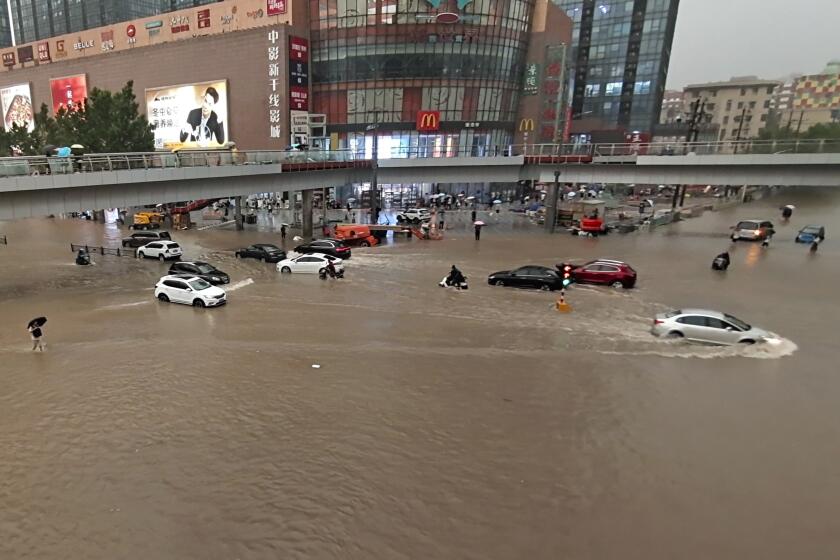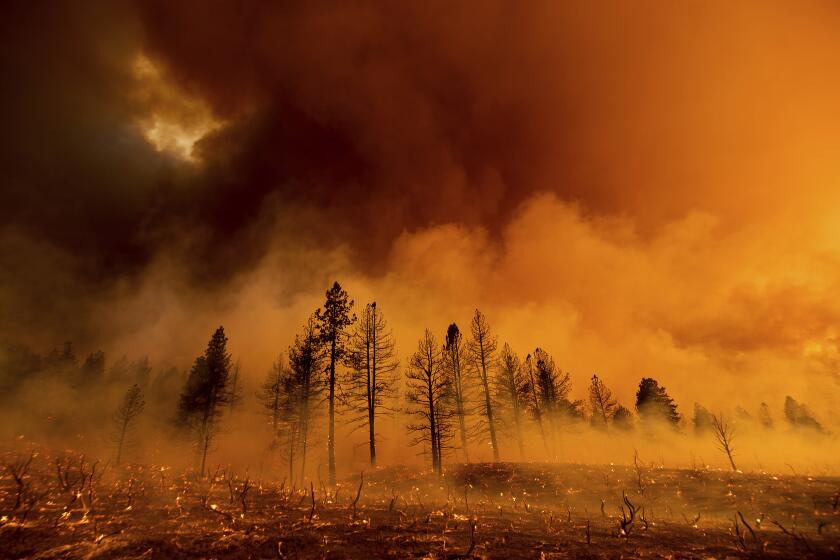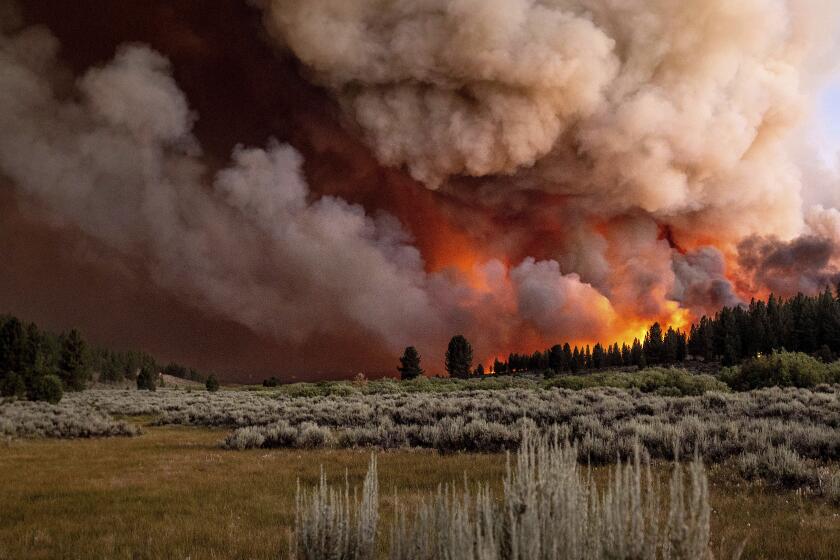Anatomy of a monster: How the Dixie fire became California’s biggest of the year
- Share via
When the first sparks ignited in the dense forest of Plumas County, the conditions were primed for a monster.
It was incredibly dry, incredibly hot and winds were on the way. Within hours, the fire had a name, Dixie, and it was scorching a fast path. In less than 10 days, it destroyed eight structures, spurred thousands of evacuations, and grew into the largest wildfire in California this year.
As of Saturday, the multicounty fire had swelled to more than 181,000 acres and 18% containment, the California Department of Forestry and Fire Protection said.
It has been difficult to fight. The terrain is steep and the fire’s erratic behavior is keeping crews at bay. Firefighters observing the immense cloud emerging from the flames have been stunned by the sight.
“I was in awe of the intensity of the smoke column,” said Eric Limones, a captain with the Cal Fire Santa Clara Unit, who snapped a photograph of his crew looking up at the ominous cloud. “I’ve been to many fires and seen this type of fire behavior before, but that day did feel a little different.”
During a community briefing this week, Cal Fire deputy incident Cmdr. Chris Waters said the Dixie fire is unlike anything he has experienced in more than two decades of fighting fires.
“The fire behavior conditions that we’re facing right now are really quite unprecedented, and at a historical level,” he said, noting that the blaze is creating spot fires as far as five miles away, which is “beyond the pale of what I’ve seen in my career.”
Yet the conditions that paved the way for the fire’s massive growth are becoming increasingly common. The West is contending with both record-breaking heat waves and worsening drought, which are meeting with bone-dry vegetation, violent weather patterns and strong gusty winds to fan the flames.
Wildfire experts said the role of climate change cannot be overstated when it comes to the year’s hotter, earlier and more frequent conflagrations. The Dixie fire, they said, will probably be the first of many in California to reach massive proportions in 2021.
Climate change is making the world more prone to floods like those in China and Europe and to heat waves and fires like those in the U.S. and Russia.
As with many other recent ecological disasters, the Dixie fire began with human error.
In a report, Pacific Gas & Electric Co. said a worker in the Feather River Canyon area found two blown fuses and a tree leaning into a power line conductor on July 13. A fire was burning at the base of the tree, according to the report, which was submitted to the California Public Utilities Commission.
Officials swarmed the area, but by 8 a.m. the next morning, the burgeoning fire had grown to 500 acres. Gusty winds and low humidity helped spur its growth, and by the end of that day, it was at 2,200 acres and growing.
Residents in the nearby town of Paradise watched with horror as the smoke began to climb. Only three years earlier, huge portions of Paradise were razed in the Camp fire, the deadliest fire in California history.
But the Dixie fire had other plans. Instead of moving toward Paradise, it began to crawl east toward Lake Almanor, prompting evacuations along the lake’s western shore and an increasing number of surrounding communities.
Although the days that followed were critical, little could be done to stop the aggressive flames from searing through the area’s dry brush and grasses.
“We’re coming out of what I would call a historic, or unprecedented, drought period,” said Waters, who is also a fire behavior analyst. “We are at conditions that wouldn’t be seen usually until we get to late September, early October ... and right now we’re in mid-July.”
On a 1-to-100 scale measuring how combustible the vegetation is, the fuels on the ground are at “99 to 100,” he said, and “fully available to burn unimpeded.”
Though the sun-baked terrain is a major factor in the fire’s progress, its growth is also being fed by its own violent behavior, experts said.
The Dixie fire has swelled with such velocity that it has created its own weather system — including a monstrous pyrocumulonimbus cloud that can be seen more than 100 miles away.
The clouds can generate dry lightning bolts that ignite additional fires, said UCLA climate scientist Daniel Swain, and can create sudden and significant gusts that fan the flames.
“That can create havoc,” Swain said of the cloud’s winds. “It’s extremely dangerous for any firefighters who are actively on the line, because it can cause the fire to suddenly shift direction and explode in intensity.”
Limones, the fire captain from Santa Clara County, said he and his hand crew were constructing containment lines near the Pacific Crest Trail when they paused to observe the cloud. They toiled with hand tools far from any water source while evaluating potential escape routes, and the cloud only added to the adrenaline.
“Those columns definitely change the weather around you, and the wind,” he said. “Those are the types of things that cause erratic fire behavior, and get people hurt.”
In 2018, pyrocumulonimbus clouds at the Carr fire in Redding grew so strong that they generated a fire tornado, which killed at least one firefighter. As the region grows hotter and drier, there is evidence that the clouds are appearing with more frequency.
“We’ve seen an extraordinary amount of them this year so far and also last year,” Swain said, “compared to any year that I can remember.”
But even when crews aren’t contending with the Dixie fire’s vicious feedback loop, they are up against steep, rocky terrain that is making their work challenging, said Cal Fire Butte County spokesman Rick Carhart.
According to Carhart, the area’s valleys, peaks and canyons regularly serve as chimney-like chutes that channel the fire. During the Dixie fire’s 30,000-acre run Thursday night, crews were met with gusts as strong as 40 mph.
“When the wind lines up with the direction of those drainages, then it can really drive the fire,” he said.
As wildfires ravage hundreds of thousands of acres across California, more is being learned about the damaging effects of their smoke.
Conditions will only get worse this weekend.
Humidity levels over the fire are nearing single digits and dropping quickly, said Dixie fire incident meteorologist Julia Ruthford.
“Over the past week, we have seen a very critical combination of different fire weather elements going on, and that trend is continuing,” Ruthford said. “Unfortunately, that critical pattern is going to continue and actually worsen over the next couple of days.”
Fire crews this weekend will also contend with heat, as temperatures Saturday are expected to climb at least five degrees to the mid-90s, she said. And the unstable conditions will allow the smoke columns to grow even higher as breezy winds advance Friday and Saturday.
Smoke from western fires — including the Dixie, Tamarack and Bootleg — are already reaching as far as the East Coast.
Researchers are increasingly warning that fumes from wildfires are nearly as dangerous as the flames themselves, with one new study linking smoke from the Camp fire to elevated lead levels as far away as Modesto.
“I really wish I had better news to tell you, something good to put in the forecast,” Ruthford said, “but it looks like we’re going to be really looking toward a very critical next three days coming up.”
Already this year, there have been more than twice as many acres burned than during the same period last year — and hundreds more fires.
More than 4,000 personnel are working to contain the stubborn Dixie fire, Carhart said Friday, including firefighters from Arizona, New Mexico and even Florida.
Their primary focus heading into the weekend is the safety of communities in the fire’s path. Already, the blaze has destroyed at least eight structures, and more than 1,500 others are threatened. Evacuation orders and warnings now span Butte, Plumas and Tehamas counties.
But gaining a foothold is proving challenging, with at least one spot fire from the Dixie’s wind-whipped embers growing large enough to generate its own name: the Fly fire.
By Friday, the Fly fire had grown to 1,650 acres with no containment, officials said, spurring additional evacuations. It was not included in the Dixie’s total acreage.
And even if crews do turn a corner on the Dixie fire, the season is just beginning. On Friday, Cal Fire announced that hot, dry conditions across the state have driven a significant increase in wildfire activity, with more than three times as many acres burning so far this year than during the same period in 2020.
And the Dixie fire — menacing as it may be — pales in comparison to the Bootleg fire, burning just over the border in Oregon. On Friday, that fire mushroomed to more than 400,000 acres and was 40% contained.
Swain said the Dixie, Bootleg and other current fires are “early indicators of the kind of potential fire severity we could see this year,” and noted that conditions across the region are ripe for more blazes.
“Because of the extreme drought, because of climate change, because of all these other factors,” he said, “if there are enough sparks, then there’s going to be a lot of 100,000-acre-plus fires.”
More to Read
Sign up for Essential California
The most important California stories and recommendations in your inbox every morning.
You may occasionally receive promotional content from the Los Angeles Times.














